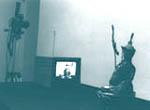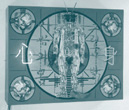 |



MEDIUM IS THE MESSAGE, April-May
1999
Paik Nam June
April 16 – May 10
Within the framework of the exhibition a seminar, dedicated to Nam June Paik’s art work, was held on April 19, 5 p.m., at Art Media center "TV Gallery". A number of well-known artists and critics who worked with Nam June Paik at different time, was speak there about his art (Marie Lucier, Eleonore Hartney, Leanne Mella, Albert Benamu).
Born in 1932 in Seul, Nam June Paik had to emigrate during Korean war in 1949, first to Hong-Kong, and then to Tokio, where he studied music and philosophy. In 1956 he defended his thesis on Schonberg, and then left for Germany, where he became a student of Fortner, a composer. When in 1958 Paik joined summer courses of new music in Darmschtadt, he got very much impressed by meeting with John Cage whose works proved to be revolitionary ones. In the citadel of serious music Cage allowed a chance, which was immediately interpreted by critics as indiscipline, and even as anarchy. Filled with new ideas, transformed and freed, in the autumn of 1959 Paik began studying at Schtokhausen Studio of Electronic Music in Cologne. Now, having forgot academism and his first works as well, Paik gave himself up to happenings and performances. A quiet String Quartet of 1955-57 is followed, without any transition, by a violent Etude for Fortepiano in 1959. During this performance the musician jumped from the stage on to his idol John Cage and cut his tie and shirt with scissors, and then sprang out of the opened window. Afterwards JohnCage will say, "Everything can be expected from Paik, even the actions which aren’t safe for one’s life". No wonder Nam June Paik became one of the leading figures of neodadaism in the 60s.
However, Paik is different from the other artists usually joined into one group. His passion for technique will let him afterwards become the founder of a different trend in art. In his letter to John Cage in 1959, he admits his being fascinated by television. In the beginning of 1963 he purchased thirteen second-hand TV-sets, and in March 1963 opened his first personal exhibition at Parnas Gallery in Vupertal, using these TV-sets presented in the style of a "treated piano" of John Cage. At the same time Paik additionally includes into the exposition three pianos and other musical instruments. On that day video art was born. This event caused much noise, the more so because of Joseph Boice’s improvisation who fell upon one of the instruments with an axe.
At this stage Paik works with a TV monitor first of all as a musician, wishing to broaden the limits of music, and the circle of musical instruments. In 1963, together with an engineer Shuia Abe, he makes Robot K-456, who can speak and walk; in1964 he opens a new installation in NewYork, arranges performances, in particular, Robot Opera with a cellist Charlotte Moorman. As he gained more experience, Paik would make television "face art".
In 1965 he bought his first video camera Sony. The taxi he hired to bring the camera home, got into a traffic jam (the Pope Paul VI visited New York that day), and Paik shot his first video film shown in GoGo cafe in October, 1965. Rockfeller’s grant helped him develop his invention, and Paik/Abe Video Synthesizer came out as a result in 1969, with the help of which it became possible to make various deformations of a picture on the screen on the air.
Now Nam June Paik became pretty famous, his works follow one another offering complicated poetics and adding certain delicacy to the process of general stupefaction by television. His task is to stir up the audience put to sleep by television, to "humanize" technology, i.e. to make a viewer a sort of creator. But, apart from this function, video awakens (and reveals) physical feelings of those
who use it. The body is first of all sex. There was such sentence in one of the musical compositions of Paik, "Take a walk in the vagina of an alive whale". Richard Kostellanets, American critic, seriously interpreted it as an example of conceptual art. Sextronic Opera which followed afterwards and because of which Paik and Charlotte Moorman were arrested on a charge of immorality, turned out to be not as much "conceptual". And when in 1969 Paik repeated this action, having changed two mini-TV-sets for Charlotte Moorman bra (TV bra for Alive Sculpture), or when he himself interacts with one of the TV-sets (TV penis), video begins compete with Body Art. The thing we watch is not sex, this is a screen where an image of a performer appears, as if it were necessary to repeat his physical body endlessly with the help of technology so that to achieve a real effect of the presence.
It is also worth noting that for Paik the body is not sex, it is a text, even a pretext, for art. Actually, does not a video sculpture My Faust (Kunsthalle, Zurich, 1991) go back to Art in its traditional interpretation, both in form and conception? No doubt, Paik’s master-piece is TV Buddha, where the statue is obsessed with contemplation of its own image on the opposite screen. Technology has never served so well for reproducing the greatness of silence.
At the exhibition "Medium Is the Message" arranged by Art Media Center "TV Gallery" together with Albert Benamu Gallery (Paris), some of Nam June Paik’s works from Albert Benamu’s collection are presented. Long-lasting friendly and creative relations connect the artist with Albert Benamu, beginning with his first performances in Paris in the 60s; his personal exhibitions at Galerie du Genie were the result of their friendship.
Art Media Center "TV Gallery"
Albert Benamu Gallery (Paris)
Publications
video 1: 256 Kbps. fragment
video 2: 256 Kbps. fragment
The site has been created with the assistance of the "Open Society Institute" (Soros Foundation). Russia
|






